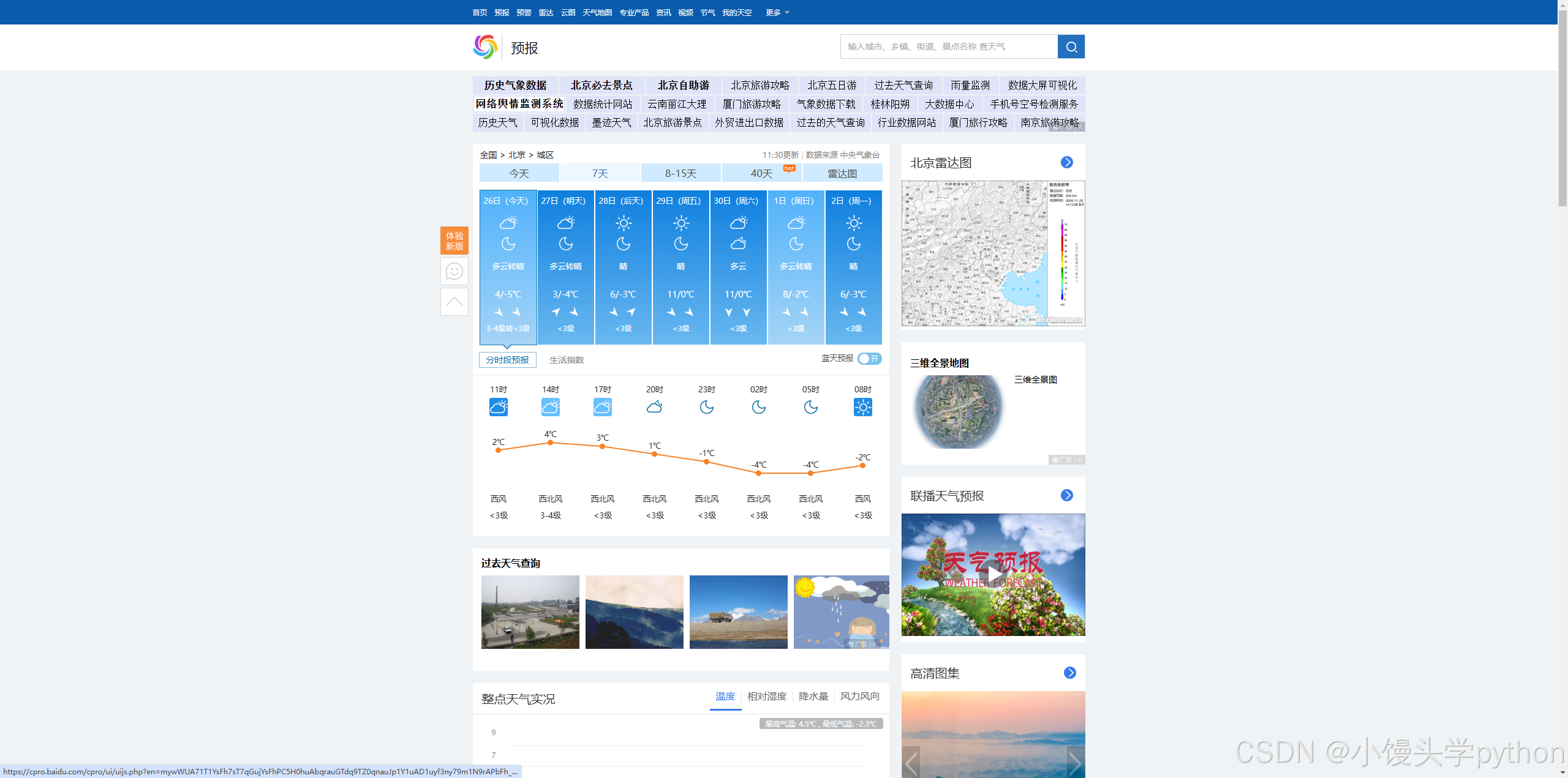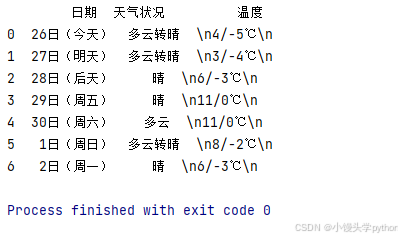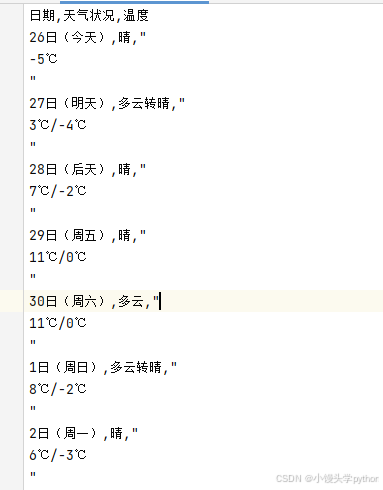
博客主页:小馒头学python
本文专栏: Python爬虫五十个小案例
专栏简介:分享五十个Python爬虫小案例

引言
天气数据在很多领域都非常重要,比如天气预报、旅游、健康等。通过爬取天气网站的公开数据,可以方便地获取各地的天气情况。本教程将向你展示如何使用 Python 爬取中国天气网(Weather China)上的城市天气数据。
爬取天气数据的意义
天气数据的爬取可以为个人用户提供定制化的天气服务,供各种应用程序使用。例如,你可以通过爬取天气数据,预测未来几天的天气变化,或提供更为精准的出行建议。
使用 Python 实现数据爬取的优势
Python 语言因为其简洁性、丰富的第三方库而被广泛用于数据爬取和处理工作。Python 中的 requests、BeautifulSoup 等库,提供了高效的网络请求和网页解析功能,使得爬虫编写变得更加简单和快速。
本文目标:教你如何用 Python 爬取中国天气网的城市天气数据
在本教程中,我们将从零开始,逐步完成爬取中国天气网指定城市天气数据的爬虫,并将数据保存为 CSV 格式文件。最后,我们还会提供一些防止爬虫被封禁的技巧,确保爬虫能够顺利运行。

准备工作
环境要求
首先,确保你已经安装了 Python(推荐 Python 3.6 及以上)。然后,你需要安装以下几个库:
python
pip install requests beautifulsoup4 pandasrequests: 用于发送 HTTP 请求,获取网页内容。
BeautifulSoup: 用于解析 HTML 内容,从中提取数据。
pandas: 用于存储和处理数据,可以方便地将数据保存为 CSV 文件。
获取中国天气网的城市天气页面
中国天气网的天气页面结构简单,适合用来进行数据爬取。每个城市的天气页面都有一个唯一的城市代码,我们可以通过该代码访问城市的实时天气信息。
例如,北京的天气页面 URL 为:
在该页面中,你可以找到北京的温度、天气情况、风速等信息。我们通过爬虫来获取这些数据。
爬虫的基本原理
HTTP 请求的基本流程
爬虫的工作原理简单来说就是:向网页发送请求,获取网页的 HTML 内容,解析该内容并提取我们需要的数据。这个过程可以分为三个步骤:
- 发送 HTTP 请求,获取网页内容。
- 解析 HTML 页面,提取目标数据。
- 将提取到的数据存储或进行进一步分析。
数据解析
中国天气网的天气页面数据是 HTML 格式,我们将使用 BeautifulSoup 进行解析。BeautifulSoup 可以帮助我们提取网页中的特定标签内容。
如何提取目标数据(城市天气)
在本教程中,我们会提取以下几种数据:
- 城市名称
- 当前天气
- 温度(包括最高和最低温度)
编写爬虫代码
第一步:发送请求,获取页面内容
我们使用 requests 库向目标城市的天气页面发送 HTTP 请求。以下是一个简单的代码示例:
python
import requests
def fetch_weather(city_code):
url = f'http://www.weather.com.cn/weather1d/{city_code}.shtml'
response = requests.get(url)
if response.status_code == 200:
return response.text
else:
print("请求失败,状态码:", response.status_code)
return None在上面的代码中,我们构建了一个 fetch_weather 函数,它接收一个城市的代码(例如北京的代码是 101010100),并返回该页面的 HTML 内容。
第二步:解析页面,提取天气数据
我们使用 BeautifulSoup 来解析 HTML 页面,并提取所需的数据。
python
from bs4 import BeautifulSoup
def parse_weather(page_content):
soup = BeautifulSoup(page_content, 'html.parser')
weather_data = {}
# 获取城市名称
city_name = soup.find('div', class_='crumbs fl').text.split('>')[-1].strip()
weather_data['city'] = city_name
# 获取当天的天气情况
weather = soup.find('p', class_='tem').find('span').text
weather_data['weather'] = weather
# 获取温度信息
temp = soup.find('p', class_='tem').text.strip()
weather_data['temperature'] = temp
return weather_data第三步:处理数据,保存到本地
将获取到的数据存储为 CSV 文件。我们使用 pandas 来将数据存储到 CSV 文件中:
python
import pandas as pd
def save_to_csv(weather_data):
df = pd.DataFrame(weather_data)
df.to_csv('weather_data.csv', index=False)
print("数据已保存到 weather_data.csv")
# 示例:爬取北京的天气
city_code = '101010100' # 北京的城市代码
page_content = fetch_weather(city_code)
if page_content:
weather_data = parse_weather(page_content)
save_to_csv([weather_data]) # 将数据保存为 CSV 文件第四步:将数据导入 CSV 文件
通过调用 save_to_csv 函数,我们将爬取到的城市天气数据保存为 weather_data.csv 文件,方便后续处理。
完整的源码
下面是完整的源码
python
import requests
from bs4 import BeautifulSoup
import pandas as pd
import random
import time
def get_weather_data(city_code):
url = f'https://www.weather.com.cn/weather/{city_code}.shtml'
headers = {
'User-Agent': 'Mozilla/5.0 (Windows NT 10.0; Win64; x64) AppleWebKit/537.36 (KHTML, like Gecko) Chrome/58.0.3029.110 Safari/537.36'}
# 获取网页内容并处理编码,避免乱码
response = requests.get(url, headers=headers)
response.encoding = 'utf-8' # 确保正确解码
soup = BeautifulSoup(response.text, 'html.parser')
# 获取当前天气
current_weather = None
current_condition = None
try:
# 检查页面结构是否有更新
current_weather = soup.find('div', class_='t').find('p', class_='tem').get_text()
current_condition = soup.find('div', class_='wea').get_text()
except AttributeError:
print("无法找到当前天气信息,可能是页面结构发生了变化")
# 获取未来天气预报
future_weather = []
for item in soup.find_all('li', class_='sky'):
date = item.find('h1').get_text()
weather_condition = item.find('p', class_='wea').get_text()
temperature = item.find('p', class_='tem').get_text()
future_weather.append([date, weather_condition, temperature])
return current_weather, current_condition, future_weather
# 示例:爬取北京的天气数据
city_code = '101010100' # 北京的城市代码
current_weather, current_condition, future_weather = get_weather_data(city_code)
# 打印当前天气
if current_weather and current_condition:
print(f"当前天气:{current_weather},状态:{current_condition}")
else:
print("当前天气信息未能成功获取")
# 将未来天气数据存储到DataFrame并显示
weather_df = pd.DataFrame(future_weather, columns=["日期", "天气状况", "温度"])
print(weather_df)运行结果:

数据保存
python
import requests
from bs4 import BeautifulSoup
import pandas as pd
import random
import time
def get_weather_data(city_code):
url = f'https://www.weather.com.cn/weather/{city_code}.shtml'
headers = {
'User-Agent': 'Mozilla/5.0 (Windows NT 10.0; Win64; x64) AppleWebKit/537.36 (KHTML, like Gecko) Chrome/58.0.3029.110 Safari/537.36'}
# 获取网页内容并处理编码,避免乱码
response = requests.get(url, headers=headers)
response.encoding = 'utf-8' # 确保正确解码
soup = BeautifulSoup(response.text, 'html.parser')
# 获取当前天气
current_weather = None
current_condition = None
try:
# 检查页面结构是否有更新
current_weather = soup.find('div', class_='t').find('p', class_='tem').get_text()
current_condition = soup.find('div', class_='wea').get_text()
except AttributeError:
print("无法找到当前天气信息,可能是页面结构发生了变化")
# 获取未来天气预报
future_weather = []
for item in soup.find_all('li', class_='sky'):
date = item.find('h1').get_text()
weather_condition = item.find('p', class_='wea').get_text()
temperature = item.find('p', class_='tem').get_text()
future_weather.append([date, weather_condition, temperature])
return current_weather, current_condition, future_weather
# 示例:爬取北京的天气数据
city_code = '101010100' # 北京的城市代码
current_weather, current_condition, future_weather = get_weather_data(city_code)
# 打印当前天气
if current_weather and current_condition:
print(f"当前天气:{current_weather},状态:{current_condition}")
else:
print("当前天气信息未能成功获取")
# 将未来天气数据存储到DataFrame
weather_df = pd.DataFrame(future_weather, columns=["日期", "天气状况", "温度"])
# 保存为 CSV 文件
weather_df.to_csv('weather_data.csv', index=False, encoding='utf-8-sig')
print("天气数据已保存为 weather_data.csv")
总结
本文介绍了如何使用Python爬虫从中国天气网爬取城市天气数据